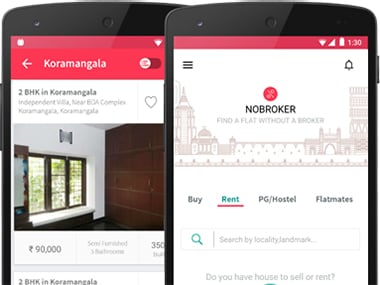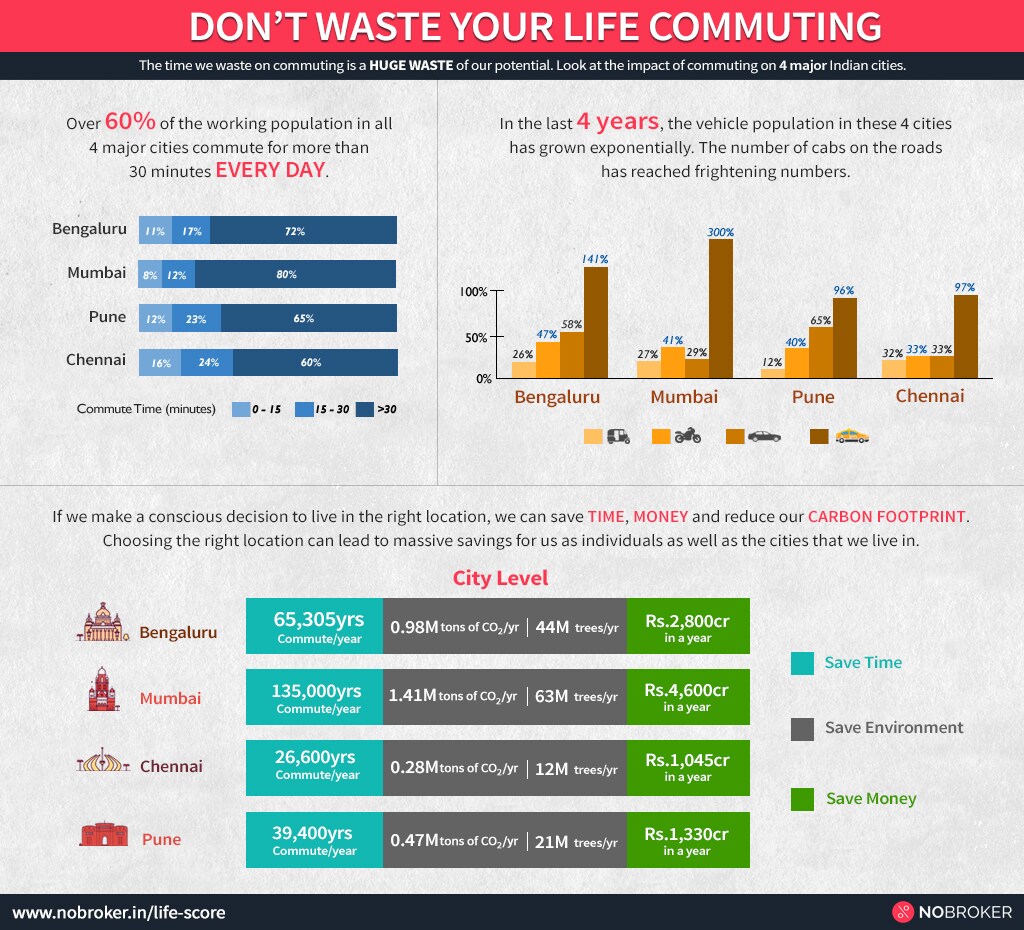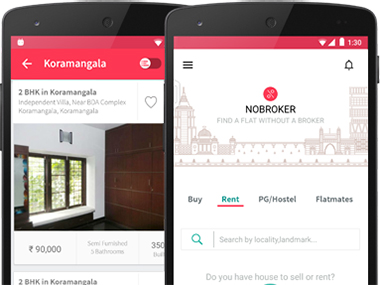NoBroker.com is a customer to customer property marketplace that makes it free for home owners and tenants to list properties and find properties by removing the broker from the equation. Typically the amount paid by both the owners and the tenants or buyers towards brokerage adds very little value to either party. This was an unnecessary intermediation cost which NoBroker.com is removing and helping the customer save. The property portal has been around for three years, and has been designed to be simple to use. More than twenty six lakh customers have used the services offered by the portal. More than 35 crores worth of brokerage charges is saved every month. Under the skin of the minimalistic interface though, there is a whole ton of powerful computing going on. [caption id=“attachment_3970677” align=“alignleft” width=“380”]  Image: NoBroker[/caption] Homeowners can list their own properties for free, and even do it through WhatsApp. NoBroker.com also crowd sources available properties through its Click n Earn program. Participants merely have to take photos of “to let” boards, and machine learning algorithms extract the details necessary for listing from these photographs. If a property is listed, then the individual who submitted the photograph gets Rs 100 in their PayTm wallets for their efforts. All of this is done in near real time. To find out more details on what exactly goes on under the hood, we spoke to founder and chief technology officer of NoBroker.com, Mr Akhil Gupta. Gupta is an IIT Bombay Graduate, who had a decade of experience in leading positions in software development at Oracle and People Fluent, before starting on NoBroker.com. Machine learning was identified early on as a solution to address pain points in how the listings are presented to the customer. One of the pain points was identifying the properties to show to the users. If there are only ten to twenty properties on the site, the user can go through every one of them. However, it is impossible for the user to scan through thousands of listed properties to find a suitable one. NoBroker.com uses machine learning to display properties that have higher chances of getting picked. One of the factors was the type of apartments that people needed considering the kind of area in the city it was. There are certain kinds of properties in demand near IT hubs, and other kinds of properties in demand where families typically reside. Gupta explains using Bengaluru as an example, “We use machine learning to understand user behavior,” says Gupta, “While looking into our data, what we identified was, near Electronic City (a major IT hub in Bengaluru), you have a much higher searchers of 1 BHK listings, in Koramangala, you have searches for 2 BHK, in Outer Ring Road also there are searches for 1 - 2 BHK. In the interiors of the city, there were searches for 3 BHK. Additionally, certain kinds of users looked for parking, good security in place, or with lots of eating joints nearby.” “We came up with something called the property ranking algorithm, where what we do is, we rank our properties based on two scores. One is the commute score, and the second is the livability score. The commute score is calculated based on how commutable that particular property is, considering how many bus stops are nearby, how far is it from metro stations, are taxis usually available in the area or not. Similarly, livability score is the space in which the society or house is located, is it surrounded by food joints? What kinds of shops are there? Are there entertainment options? Is there a mall? People look for a mall.” “These two scores are combined with the characteristics of the property, such as if the property is fully furnished, and the rent the owner is asking for. Now we have closed thousands of transactions on our platform, we know what exactly the prevailing rent is. We came up with a system called a rent-o-meter, which knows exactly what should be the rent of a listed property. So the rent that our algorithm suggests, plus the rent at which the user has listed the property, along with the commute score, and the demand that we have in a particular area, along with the age of the property, how many impressions the property has got, based on all this we calculate the popularity of the property.” “Ideally our system predicts it takes between 18 to 23 days for a good property to get rented out. If the system knows that the property has been listed for some time, it will not show the particular listing higher up, as it knows that the property is likely to have been rented out. It can understand that so many users have already interacted with the listing.” When a user goes on to the web site and searches for a property, the rankings are customised to that particular search, to show the most ideal properties right on top. This increases the chances of a user finding a suitable location to stay in, as well as for home owners to successfully rent out or sell their houses. “The data tells us that when a user comes on, nobody scrolls beyond 28 - 29 properties,” Gupta adds, “our ranking algorithms try to show the best 28 - 29 properties for that user, depending on the search criteria and the locality where they are looking for the property.” The whole process is known as the “property discovery algorithm”. All of this is invisible to most users. For an owner, it does not matter how exactly the discovery is happening. Gupta says, “If there is a residential property in a very good area, if it is not getting rented out, then the user will say NoBroker.com is useless. It may happen because the owner has asked for higher rent.” This is when the rent-o-meter comes into the picture. This is the machine learning algorithm that comes up with a suitable amount for renting a property based on the attributes of the listing, the livability score, and historical data. If a user has a higher rent, then the algorithm kicks in and tells the user that the rent is too high. “Now, we are going one step ahead,” says Gupta, “Now it can say, if your rent is x, it will take 9 days to rent it out, if your rent is x+1 it will take 15 days for you to rent it out, if your rent is x+2, the property may not even get rented out.” This algorithm prevents loss for the owner, because for every day that the property stays vacant, the property owner is not losing money. What NoBroker.com does is that it matches the available property with the prevailing demand in the market. “By using machine learning algorithms, we are trying to solve the problem both for the owners and the tenants,” Gupta says. The benefit for NoBroker.com of doing this is that they are able to close more property deals. The machine learning algorithms basically bring about a kind of equilibrium between the demand and supply side of the market. The Click N Earn program is pretty easy it participate in, and allows users to earn a few extra rupees on the side while just walking down roads. Users have to use the Click N Earn section of the NoBroker.com app to snap photos of “To Let” boards, and the machine learning algorithms do the rest. More than 33 percent of the listings on the platform come through this program. There are thousands of images uploaded the site every day. Normally, for humans to process all of this information would require looking at the photos, manually entering the details into a form, checking if the listing already exists, and then pay the user who submitted. This is a repetitive job. NoBroker.com got in an AI algorithm to solve this problem as well, and uses Google’s Cloud Vision API. The algorithm uses optical character recognition (OCR). “If you take a photograph and upload it on our system,” explains Gupta, “Immediately, our system will extract the phone number, it will check if an owner already exists with the particular phone number, if not, the user will immediately get the payment.” Executing this in near realtime ensures that users who are submitting the listings do not feel cheated if a property they have snapped already exists in the system. A LifeScore section uses artificial intelligence to figure out how much you can save every month by moving to a better location in the city. These savings are shown in terms of time, money, as well as the environmental impact of a reduced commute. Gupta explains, “We have been here for long, and we have a lot of data. In Bengaluru, what has happened in the last couple of years is that we have stopped calculating distances in kilometers.” This is entirely true. Bengaluru is my hometown, and I studied there for two years. The traffic situation is so bad that distances between two places is measured in the number of hours spent in travel. “Even if the office is five to seven kilometers of your house, it takes a lot of time depending on where you stay and what part you travel through. We came up with something called LifeScore. You can check whether you are staying at the right location or not. We take your office address we take your current residential address, we take the rent you are paying and the type of house you are staying in. Then we run all this information through algorithms that estimate how much time it will take to commute, for which we use the Uber and Ola APIs. We calculate how much fuel will be burnt and how much carbon dioxide is generated. And then we make a report out of it.” [caption id=“attachment_4032555” align=“aligncenter” width=“1024”]  Image: NoBroker[/caption] LifeScore **uses artificial intelligence to figure out how much you can save by simply moving to a better location** . The app is particularly useful for users who are renting out an accommodation. Users simply have to feed in their current location and the location of their work place. Then Life Score finds out an accommodation closer to the workplace and shows how much you can save every month in terms of money and time because of the shorter commute, and perhaps a cheaper place available on rent. At times the suggested locations may not be closer to the office in terms of distance, but may be closer in terms of time. The technology was used to compute how much entire cities were able to save if every resident was at an optimum location with respect to their jobs. If Everyone in Mumbai moves to the right place, the residents can save Rs 4,600 crore a year, and prevent the generation of 1.41 million tons of carbon dioxide, which is the equivalent of planting 63 million trees. NoBroker.com is currently available in Chennai, Pune, Bengaluru, Gurgaon and Mumbai. The NoBroker.com app is available for free on Android and iOS.
The machine learning algorithms basically bring about a kind of equilibrium between the demand and supply side of the market.
Advertisement
End of Article


)



